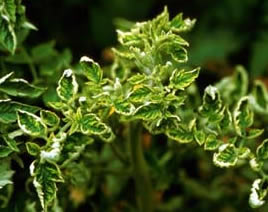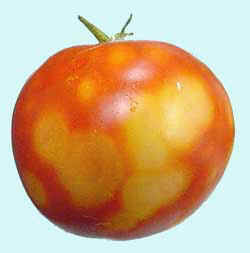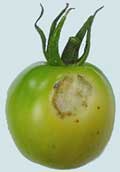|
Pests
Tomato fruit worm (Heliothis armigera)
Caterpillars feed on leaves and other vegetative parts in the initial stage. Later
cause extensive fruit damage by entering through cut holes and burrows and feeding
the internal content. Infestation is severe during October-March.
Control: Judicious use of synthetic pyrethroids like fenvalerate (50g a.i./ha) or
deltamethrin (10g a.i./ha) controls the fruit borer.
Epilachna beetles (Epilachna vigintioctopunctata)
The yellowish grubs and adults feed voraciously on the leaves and tender parts of
the plant, and completely skeletonizes the leaves leaving only a network of veins.
The pest often causes serious defoliation when appeared in large number.
Control: Collection and destruction of infested leaves along with the grubs, adults
and eggs reduces the pest incidence. Spraying malathion (2ml/litre of water) or
carbaryl (2-4 g/litre of water) effectively controls the pest.
Jassids (Amrasca biguttula biguttula, Cestius
phycitis)
Nymphs and adults of the pest suck sap from the lower surface of the leaves and
infested leaves curl upward along the margins, turn yellowish and show burnt up
patches. Fruit setting is also adversely affected. The pest is the natural vector
of mycoplasmal disease like little leaf and viral disease like mosaic.
Control: Spray malathion (0.1%) or dichlorvos (0.05%) 20 days after transplanting.
Tabacco caterpiller (Spodoptera litura)
Caterpillars feed gregariously on tender leaves, shoots and fruits at night. The
pest is confined to nursery beds and assumes cutworm habits. The adult moths are
greyish brown coloured with white marking on upper wings.
Control: Spray nuvan (0.5 ml/ 2 litres of water). Avoid the use of highly toxic
insecticides.
Whitefly (Bemisia tabaci)
Minute milky white flies and their nymphs suck cell sap from the leaves. The
affected leaves curl and dry up, and growth of the plant is stunted. White flies
act as a vector of leaf curl virus causing severe yield loss.
Control: 2-3 sprayings with dimethoate (0.05%) at fortnightly intervals starting
with the appearance of the pest also effectively control the pest.
Mites (Tetranychus cucurbitae)
Nymphs and adults suck cell sap from the foliage and flower buds. White patches
appear on the affected leaves. The leaves later become mottled, curl, turn brown
and fall. Different stages of mite are found in colonies covered by white silky
webs on lower surface of leaves. Low relative humidity favours mite multiplication.
Control: Proper irrigation and clean cultivation practices including cutting and
burning of severely infested plant parts help to keep the pest population under
control. Acaricides like dicofol (0.05%) and wettable sulphur (0.3%) gives effective
control of mites.
Root knot nematodes (Meloidogyne spp.)
The nematodes invade the roots of tomato forming characteristic galls on roots.
The symptoms of aerial infection include stunted plant growth, chlorosis and tendency
to wilt under moisture stress during hot, dry weather. When the nematode population
is high, plants of a susceptible variety may die before reaching maturity.
Control: Complete elimination of nematodes from field is not possible. However,
use of resistant varieties and crop rotation with non host crops like marigold,
maize, onion, etc. reduces the nematode infestation. Application of neem oil cake
(1-1.5 t/ha) 15 days after transplanting also helps to suppress the nematode population.
Diseases
Bacterial wilt (Pseudomonas solanacearum)
It is one of the most serious diseases of tomato crop. High soil moisture and soil
temperature favour disease development. Characteristic symptoms of bacterial wilt
are the rapid and complete wilting of normal grown up plants. Lower leaves may drop
before wilting. A white streak of bacterial ooze comes out when infected plant parts
are cut and immersed in clear water.
Control: Uproot and destroy the plants affected by bacterial wilt. Cultivate resistant
varieties like Sakthi, Mukthi and Anagha and crop rotation with
non host crops is also recommended in bacterial wilt prone areas. Seedling treatment
with streptocycline (1 g/40 litres of water) for 30 min protects the seedlings in
the initial stages of growth.
Damping off (Pythium aphanidermatum)
A serious disease in the nursery. High soil moisture, moderate temperature and high
humidity especially in the rainy season favour the disease. Two types of symptoms
are observed, viz., pre emergent and post emergent damping off. The pre emergent
damping off results in rotting of seed and seedling before emerging out of soil,
whereas in the post emergent damping off, seedlings after emergence are infected
near the collar region at ground level. The infected tissues become soft and water
soaked. The collar portion rots and ultimately the seedlings collapse and die.
Control: Avoid continuous raising of nursery in the same plot. Sow the seeds as
thin as possible in the raised beds prepared in the open area during summer months.
Use healthy seeds treated with thiram (2g/kg of seed) for sowing. Soil solarization
by spreading 250 gauge polythene sheet over the bed for 30 days before sowing and
application of biocontrol agent Trichoderma viride in soil @ 5 kg/ha
is also found effective to considerable extent. Spray nursery and main field with
1% bordeaux mixture at monthly intervals.
Early blight (Alternaria solani)
Serious foliage disease characterized by the appearance of leaf spot and leaf blight.
Symptom starts as small, black lesion, usually on the older leaves, which later
enlarge with concentric rings in a bull’s eye pattern, with the surrounding
tissue being yellow in colour. High temperature and humidity favour the disease
and result in serious damage to foliage. Stem infestation show girdling of the plant
near the soil resulting in death of the plant. Infected fruits show lesions and
concentric rings.
Control: Removal and destruction of the affected plant parts and crop rotation helps
to minimize the disease incidence. Spraying the crop with dithane M-45 (0.2 %) or
bavistin (0.1 %) is recommended for effective disease control.
Buck eye rot (Phytophthora parasitica)
A serious disease in tomato growing tracts. The pathogen attacks only fruits and
does not affect the foliage thus differing from late blight. Disease starts as greyish
green or brown water soaked spot on lower fruits that touches the soil, which later
enlarges forming concentric rings of alternately dark brown and light brown bands.
Affected young green fruits become mummified.
Control: Providing good drainage, staking plants and removing foliage and fruits
up to a height of 15-30 cm from ground level helps to control the disease. Spraying
with dithane M-45 (0.2 %) four times at an interval of 10 days effectively controls
the disease.
Late blight (Phtophthora infestans)
Symptoms usually begin on the shoulders of the fruit as large, green to dark brown
lesions, which later turn brown destroying large areas of tissue. White mouldy growth
appears on the lower leaf surface and fruits. Humidity coinciding with mild temperatures
for prolonged periods favours the disease development causing severe economic losses.
Control: Follow crop rotation with non host crops and avoid planting tomatoes near
potatoes. Select disease free seeds and seedlings for planting. Treat the seed with
thiram (2-3 g/kg of seed) before planting. Spray dithane M-45 (2 g/kg of seed) at
15 days interval, starting from 30 days after transplanting.
Fusarium wilt (Fusarium oxysporum lycopersici)
It is a serious disease affecting young seedlings in the nursery and main field.
Symptoms start as clearing of the veinlets and chlorosis of the leaves. Soon the
petiole and the leaves droop and wilt. The younger leaves may die in succession
and the entire plant may wilt and die in a course of few days. In main field, lower
leaves of seedlings become yellow, wilt and die.
Control: The nursery should be regularly inspected and wilt affected plants should
be removed and destroyed. Prior to planting, the beds should be drenched with carbendazim
(0.1%) and the seeds should be treated with the thiram (2.5 kg/ha). Crop rotation
with non host crops like cereals helps to reduce the disease inoculum.
Powdery mildew (Leveillula taurica)
The disease occurs severely during dry seasons. A white powdery coating of the fungal
growth appears on the leaf surface. Infected leaves may be stiff, narrow and smaller
in size. The fungus progressively attacks new leaves, spreading over leaf stems,
twigs, and even the fruit. Terminal growth of the affected shoot is stunted or killed.
The fruit yield is reduced and the affected fruit are smaller in size.
Control: Spraying with karathane (0.1%) or wettable sulphur (3 g/ litre of water)
twice at an interval of 10 days helps to control the disease.
Tomato mosaic virus (TMV)
The disease is characterized by light and day green mottling on the leaves often
accompanied by wilting of young leaves in sunny days. The leaves are usually distorted,
puckered and smaller than normal. The affected plant appears stunted, pale green
and spindly. The virus spread through implements and plant debris.
Control: Select seeds for sowing from healthy plants. Soaking of the seeds in a
solution of trisodium phosphate (90 g/litre of water) a day before sowing helps
to reduce the disease incidence. The seeds should be thoroughly rinsed and dried
in shade. In the nursery all the infected plants should be removed carefully and
destroyed. Crop rotation with crops other than tobacco, potato, chilli, capsicum,
brinjal, etc. should be undertaken.
Tomato leaf curl virus (TLCV)
One of the most devastating diseases of tomato transmitted by whitefly. The disease
is characterized by severe stunting of the plants with downward rolling and crinkling
of the leaves. The newly emerging leaves exhibit slight yellow colouration and later
show curling symptoms. Older leaves become leathery and brittle. The infected plants
look pale and produce more lateral branches giving a bushy appearance. The nodes
and internodes are significantly reduced in size and the plants remain stunted.

|
|
Control: Removal and destruction of affected plants and removal of alternate and
collateral hosts harbouring the virus provide good control. Two to three foliar
sprays with dimethoate (0.05%) at 10 days intervals are effective. Raising 5-6 rows
of boarder crops all around the tomato plot 50-60 days before planting tomato checks
incoming whiteflies from entering into tomato crop minimizing the disease spread.
Mulching the soil just before transplanting with white, blue, grey or black polythene
sheets just before transplanting of tomato is also found effective.
Tomato spotted wilt virus (TSWV)
Numerous small, dark, circular spots appear on younger leaves. Leaves may have a
bronzed appearance and later turn dark brown and wither. Fruits show numerous spots
with concentric, circular markings. On ripe fruit, these markings appear as alternate
bands of red and yellow. The spotted wilt virus is transmitted through thrips.

Control: Removal and destruction of affected plants and separativng and removal
of alternate and collateral hosts harbouring the virus provide good control. Checking
the population of thrips by giving two to three foliar spray using dimethoate (0.05%)
at 10 days intervals reduces the disease incidence.
Anthracnose (Colletotrichum phomoides)
Fruit show small, slightly sunken, water soaked spots, which later enlarge, become
darker in colour, depressed and have concentric rings. Under warm and humid conditions,
the fungus penetrates the fruit, completely destroying it. Mature fruits nearing
maturity are more susceptible to the disease.
Control: Providing adequate drainage, crop rotation and a prophylatic fungicide
spray can control the disease.
Physiological disorders
Blossom end rot
Blossom end rot is a physiological disorder of tomato that can appear as water soaked
spots on the blossom end of the fruit. These spots later enlarge and become black.
Deficiency of calcium in the developing fruit, extreme fluctuations in moisture,
root pruning and excessive nitrogen fertilization result in blossom end rot.
Control: Avoid excessive application of nitrogen particularly in ammoniacal form.
Application of lime or calcium based fertilizers like calcium ammonium nitrate as
basal dose reduce this physiological disorder. Foliar spray of calcium chloride
(3 g/litre of water) also controls this disorder.
Sunscald
Tomato fruits nearing maturity when exposed to the sun show scald with blistered
water soaked appearance. Rapid desiccation leads to sunken area, which usually has
white or grey colour in green fruit or yellowish in red fruits. Any factor causing
a loss of leaves, such as disease, will expose fruits to sunlight and increase chances
for sunscald.

Control: Covering exposed fruits reduce the incidence of sunscald.
Cracking
Cracks results from extremely rapid fruit growth brought on by periods of abundant
rain and high temperatures, especially following periods of stress. It is common
during rainy season when temperature is high, especially when rain follows long
dry spell. Cracks of varying depth radiate from the stem end of the fruit, blemishing
the fruit and providing entry for decay causing organisms. Radial cracking is more
likely to develop in full ripe fruit than in mature green ones. Fruits exposed to
sun develop more concentric cracking than those, which are covered with foliage.
Top
|